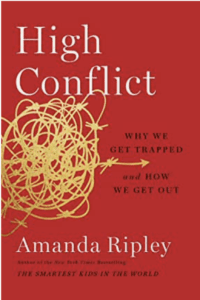
Free Book! High Conflict – How To Communicate with People Who Hold Opposite Views
Do you find yourself avoiding people who hold an opposing political view, or self-censoring your words to avoid starting a fight?
Civil discourse has declined, in America and around the world. It’s hard to have an everyday conversation sometimes. That fact weighs heavily on individuals and our cultures.
In her book, High Conflict: Why We Get Trapped and How to Get Out, Amanda Ripley addresses how to restart and restore civil dialogue. High Conflict is one of my favorite books of the year.

This book is for you if you wonder:
- How can we listen to someone who holds an opposing viewpoint and start an honest dialogue again?
- How can we communicate with people who do not seem to listen to facts or reason?
- How can we take a smarter approach to talk to people with opposing views?
The book contains some great lessons on effective messaging. Its lessons can help you understand your audience better, so you can improve the quality and merit of your Message Maps.
Make a message your audience can hear
For example, when talking to others, it’s critical to choose words that make you hearable by your audience. Ripley encourages readers to always ask 3 questions before speaking:
- Does it need to be said?
- Does it need to be said by me?
- Does it need to be said by me right now?
Speak up only when you get three yes answers.
Reading this book can help you better understand and appreciate what audiences need from your message.
Do you understand your audience’s moral foundations?
Whether you’re on the left or right, six moral foundations shape people’s political views. These moral foundations are care, fairness, liberty, loyalty, authority, and sanctity.
In short, liberals focus on three of the six moral foundations – care, fairness, and liberty – while conservatives value all six.
Dialogues break down precisely because liberals ignore conservatives’ concerns about loyalty, authority, and sanctity.
Liberals who preach to conservatives about taking care of the planet deliver a message that doesn’t land with a conservative audience. They need to change tack.
Why? Because when liberals profess their own beliefs, they appear not to understand the worldview of conservative people in the audience.
Instead, liberals need to address the moral foundations that conservatives care about – such as the need to protect the purity of nature.
Watch out for conflict entrepreneurs

Ripley’s book teaches the need to beware of conflict entrepreneurs, people who stand to gain money, attention, or bragging rights by igniting needless conflicts. For example, conflict entrepreneurs sparked and poured gasoline on fake facts and disinformation about the pandemic – confusing people and costing lives.
Good conflict is healthy, but what content entrepreneurs push is unhealthy reality distortion. High conflict takes on a life of its own and leaves everyone worse off.
What if you find high conflict in your workplace?
You may see examples of high conflict happening in your workplace. Do you work with someone who sends EMAILS IN SCREAMING ALL CAPS?
If so, here’s Ripley’s Harvard Business Review article for you, “How to Work with Someone Who Creates Unnecessary Conflict.”
While conflict entrepreneurs can appear anywhere, it turns out that certain types of employers are much more likely to employ conflict entrepreneurs — such as hospitals, universities, and political and advocacy organizations.
High Conflict shows marketers how to understand their audience’s worldview before they try to create a message that can change people’s minds.
Related Posts
Marketers Prove Curious about Messaging, Content, and Presentations in 2023
Thank you for being among thousands of marketers who read our blogs. Your reading habits revealed which topics you’re most interested in this year....
Marketers: How to get back on track when you feel overwhelmed
I was overwhelmed. One of our beloved pets passed away. It was the final straw for me after years of pandemic life and stress...
Who needs better messaging?
7 ideas on how you can create better messaging When you ask Sales what they want the most from Marketing, their answer may surprise...
Creating a strategic message? Think like your audience
Creating a strategic message helps companies deliver a clear, compelling message to the market. My business partner George Stenitzer and I have conducted hundreds...





